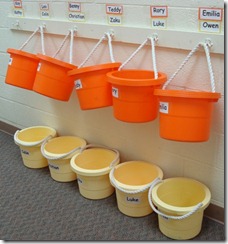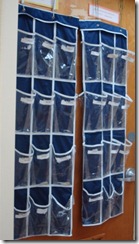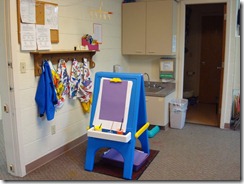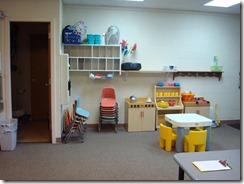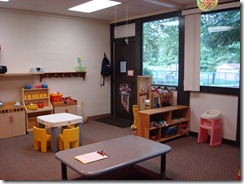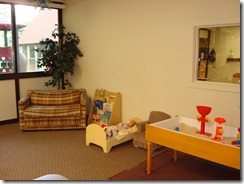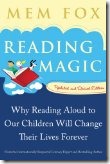I haven’t posted in awhile. But as everyone is getting ready for school, you’ll forgive me. This year I’d like to show you around my classroom. We’ve made some changes this year and I like them. The other two teachers I work with made some of my thoughts turn into a real room. We all need such nice people who help us to do what needs to be done.
So, on with the show!
To the left of my door (and this text) we have the hooks outside the door with the children’s names on them. Each child gets a bucket for the year in which to put his or her spare clothes and which we use to put art to be taken home. The buckets are big enough to put boots and raincoats in them. I have two classes named after colors (take a guess what they are) so there are two rows of buckets waiting.
To the right are our mailboxes. I believe their original purpose was as shoe organizers, but they work pretty well for family mail. Each family has a mailbox outside each of their children’s classrooms (this is located to the right of my classroom door). Families with multiple children have a dot on all but one of their box labels to indicate that school-wide items only need to be put into one box. I tend to use electronic communications more than paper, so my families only get school-wide stuff in their boxes.
Step inside the door and turn to your immediate left. There you’ll see the easel and our classroom sink. We ask that parents help their children to wash their hands immediately upon arrival. The door to the right of the sink is our scary little bathroom. We’re very limited in what we can do to make it nicer, but we’re working on it. Most of our kids aren’t using the bathroom yet except for the sink. It’s nice to have two sinks, isn’t it? I highly recommend it!
If you turn your body a little to the right you’ll see the next picture. The bathroom door is still there, but then you see cubbies up above and stacked chairs with the housekeeping area next to them. Why both cubbies and buckets, you ask? The cubbies are for diapers and wipes, since the changing table is on the wall against the bathroom. The kitchen play area tends to move around a bit, and this is the first year I’ve had it there. We don’t use chairs much. The kids sit in them for snack, but at their heights they usually have more leverage at the tables without chairs. I typically put two chairs at each of our two tables. We can always get more, but if they aren’t used they’re in the way. Chairs have to be stacked at night for vacuuming.
Turn to the right a bit more you’ll see the kitchen area again and one of our tables. We usually use one table for play dough and the other for art experiences or a manipulative that doesn’t fit on the shelves. You’ll also see the door to the play yard. Hanging next to the door is our classroom backpack. In the backpack we keep first aid supplies, medication, and all the emergency cards. The backpack goes with us wherever we go, so if we ever need to leave the school for any reason we can get a hold of everyone’s adults.
Turn a little more to the right and you can see the other shelves. I didn’t think to show you what’s on them, but it’s mostly blocks, vehicles, instruments, phones, and tools right now. That will change as the year goes on and we get to know everyone.
Turn to the right again and you’ll see our reading area. Not five minutes after I took this picture someone covered the couch, so it’s much prettier in real life than you would think. There’s also the doll bed and wee chair for nurturing dolls and listening to stories. We’ve left the wall empty for now. Between these two pictures you can see our sensory table (filled with sand right now) and our one-way mirror. We are the only room with such a mirror in the school and it is dead handy for those separation anxiety parents.
To the right again is our big closet in the corner. The metal cabinet belongs to the church, which uses our room for child care during services. My room is small so it’s hard to have an extra cabinet I can’t use, but it’s in a better location than where it’s been the last 5 years so I can’t complain. At the edge of the photo is the edge of my door, so we’re all the way around now.
Here’s what the room looks like when you’re standing in the door: 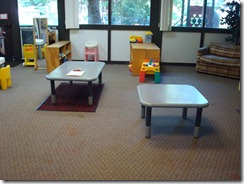
Pretty spare, isn’t it? I purposely left the room very plain this year. As the kids start making stuff we’ll put that on the walls. If they come up with an obsession or interest we’ll decorate with that in mind. I’ve found, over the last two years, that kids get very over-stimulated in school. I’m trying to keep it cool for awhile until we get to know everyone. Everyone who knows what a clutter bug I am has been telling me how nice the room looks this year. Dirt may not stand a chance with me, but I find it hard to remember to put things out of the room as fast as I bring them in. We’ll see how the year goes.
I forgot to take a picture of the fabulous geometric shapes hanging from the ceiling. Our music teacher makes them for fun and the kids adore them.
There it is, a tour of my room!

